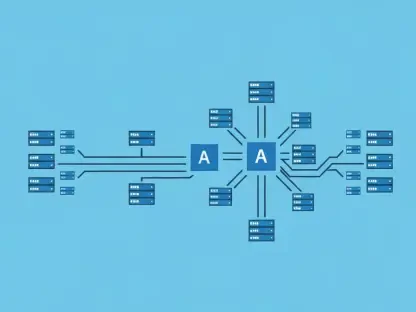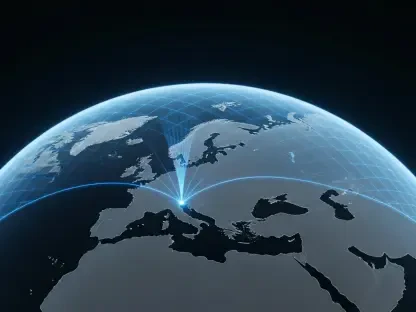In an era where digital threats evolve at an unprecedented pace, the cybersecurity landscape has been fundamentally transformed by the rise of zero trust security, a model that challenges the outdated notion of inherent trust within networks. This approach, grounded in the principle of “never trust, always verify,” mandates continuous authentication and authorization for every user, device, and interaction, regardless of location or context. As remote work, cloud computing, and sophisticated cyberattacks redefine organizational vulnerabilities, the urgency for robust zero trust solutions has never been clearer. Businesses across industries are grappling with the dissolution of traditional network boundaries, making this security framework a cornerstone for safeguarding sensitive data and critical systems. This article delves into the forefront of this vital field, spotlighting the leading companies that are shaping the zero trust paradigm with innovative tools and strategies. From identity and access management to cloud-native platforms, these pioneers are addressing the complex challenges of a perimeter-less digital world. Readers, whether IT professionals or business decision-makers, will gain valuable insights into the key players driving this critical shift, understanding how their solutions mitigate risks in an increasingly distributed environment. Prepare to explore a comprehensive overview of the innovators redefining cybersecurity through zero trust principles, offering a roadmap for organizations aiming to fortify their defenses against ever-evolving threats.
The Essence of Zero Trust Security
In the current digital age, zero trust security represents a paradigm shift from the traditional “castle and moat” model, which assumed safety within a defined network perimeter, and instead insists on constant verification of every entity—be it a user, device, or application—before granting access to resources. This shift is driven by the reality that threats can originate from anywhere, inside or outside an organization, especially as remote work and hybrid environments become the norm. The core idea revolves around minimizing risk by ensuring no implicit trust is granted, requiring explicit authentication at every step. This approach is particularly relevant as organizations face increasingly sophisticated attacks that exploit even the smallest vulnerabilities. By focusing on continuous monitoring and strict access controls, zero trust helps mitigate the potential damage of breaches, assuming that a compromise is always possible. For businesses navigating a landscape of dispersed workforces and cloud-based systems, adopting this mindset is not just a precaution but a necessity to protect critical assets from unauthorized access and lateral movement by malicious actors.
The significance of zero trust extends beyond mere technology; it embodies a strategic mindset that aligns with today’s borderless digital ecosystem, where security must adapt to new realities. Key drivers, such as the proliferation of cloud services where data often resides outside conventional boundaries, have eroded the effectiveness of perimeter-based defenses. Additionally, the rise of mobile device usage and the prevalence of remote access points have further complicated security postures, making traditional methods obsolete. Regulatory pressures for data protection and the growing threat of insider risks also push organizations toward stricter frameworks. Zero trust addresses these challenges by enforcing policies that limit access to only what is necessary, reducing the attack surface. As cyberattacks grow in complexity, with ransomware and phishing schemes becoming more targeted, this model offers a proactive stance, ensuring that even if credentials are stolen, the damage is contained through microsegmentation and ongoing validation. Understanding these dynamics is crucial for any organization aiming to stay ahead of threats in a rapidly changing environment.
Driving Forces Behind Zero Trust Adoption
The rapid adoption of zero trust security is fueled by a convergence of transformative trends reshaping how organizations operate, making it essential to adapt to new realities. One of the most significant factors is the widespread shift to remote and hybrid work models, which have dismantled the concept of a secure, centralized office network. Employees now access systems from diverse locations, often using personal or unsecured devices, creating multiple entry points for potential threats. This distributed workforce dynamic necessitates a security approach that verifies every interaction, regardless of where it originates. Coupled with this is the exponential growth of cloud adoption, where critical applications and data are hosted outside traditional infrastructure, further blurring network boundaries. These environmental changes demand a framework that can adapt to a decentralized reality, ensuring protection across varied and dynamic access scenarios without relying on outdated perimeter defenses.
Beyond workplace transformations, the escalating sophistication of cyber threats plays a pivotal role in driving zero trust strategies, as attackers are leveraging advanced tactics like social engineering and zero-day exploits to bypass conventional security measures. Insider threats, whether malicious or accidental, also pose significant risks, as trusted individuals can inadvertently become conduits for breaches. Simultaneously, regulatory landscapes are tightening, with mandates requiring stringent data protection and privacy controls, compelling organizations to adopt robust verification processes. Zero trust counters these issues by enforcing least-privilege access, ensuring users only interact with resources essential to their roles, and by maintaining continuous oversight to detect anomalies swiftly. As compliance becomes a boardroom priority, this model provides a structured way to meet legal obligations while fortifying defenses against both external and internal dangers, making it an indispensable tool for modern enterprises.
Spotlight on Leading Zero Trust Innovators
Among the frontrunners in zero trust security, Zscaler emerges as a pioneer with its cloud-native Zero Trust Exchange platform, designed to deliver secure access for distributed workforces. Its offerings, such as Zscaler Internet Access and Zscaler Private Access, focus on identity-based authentication and microsegmentation, effectively replacing cumbersome VPNs with scalable, user-friendly alternatives. This makes Zscaler particularly appealing to organizations embracing cloud-first strategies, as it ensures continuous verification without the friction of traditional tools. While its reliance on cloud infrastructure might pose challenges for entities with limited cloud maturity, its ability to provide inline threat prevention and seamless remote access positions it as a leader for businesses prioritizing flexibility. Zscaler’s emphasis on Secure Access Service Edge (SASE) further aligns with current trends, integrating networking and security to safeguard users regardless of location, highlighting its role as a transformative force in the cybersecurity domain.
Palo Alto Networks stands as another titan, offering a comprehensive zero trust framework that spans network, cloud, and endpoint protection. Through solutions like Next-Generation Firewalls, Prisma SASE, and Cortex XDR, it provides an end-to-end security posture bolstered by advanced threat intelligence. This integrated approach is ideal for organizations already invested in its ecosystem, seeking a unified solution to cover multiple security layers. However, the complexity and cost of managing such a broad portfolio can be daunting, requiring significant expertise and resources. Despite these challenges, Palo Alto Networks excels in delivering a cohesive security fabric that minimizes gaps, making it a go-to choice for enterprises aiming to implement a holistic zero trust strategy. Its adaptability to diverse environments underscores its prominence among industry leaders driving this critical security shift.
Microsoft also commands attention with its deeply integrated zero trust suite, leveraging tools like Azure Active Directory for identity management and Microsoft Defender for Endpoint protection. Its seamless alignment with the broader Microsoft ecosystem, including Windows and Microsoft 365, offers a cost-effective option for organizations already using these platforms. The focus on compliance and data governance through solutions like Microsoft Purview further enhances its appeal, especially for enterprises navigating regulatory demands. While its capabilities may be less comprehensive outside its ecosystem, the ease of integration and familiarity for existing users make it a formidable player. Microsoft’s approach demonstrates how zero trust can be embedded into everyday tools, reducing adoption barriers and ensuring robust protection across cloud and on-premises environments, solidifying its position at the forefront of cybersecurity innovation.
Diverse Approaches to Zero Trust Solutions
Cisco capitalizes on its extensive networking expertise to deliver a robust zero trust portfolio, featuring solutions like Secure Access by Duo for multi-factor authentication and Secure Firewall for network defense. Unified through the SecureX platform, these tools provide broad coverage across identity, endpoint, and network domains, making Cisco a natural fit for organizations with existing infrastructure from the company. The breadth of its offerings, however, can introduce complexity in management, necessitating careful planning and skilled personnel to fully leverage its capabilities. Despite this, Cisco’s ability to integrate security across various layers ensures a comprehensive defense mechanism, preventing lateral movement of threats within networks. Its longstanding reputation in networking, combined with a forward-thinking zero trust approach, cements its status as a key influencer in shaping secure digital environments for enterprises of all sizes.
Cloudflare brings a unique perspective by combining performance with security through its global network, offering solutions like Cloudflare Access and Gateway for zero trust implementation. Its developer-friendly APIs and emphasis on low-latency access cater to cloud-first organizations, ensuring that stringent security measures do not impede productivity. This focus on user experience sets Cloudflare apart, particularly for businesses with distributed teams requiring fast, reliable connections. While its primary reliance on cloud infrastructure may require adjustments for traditional setups, its competitive pricing and scalability make it an attractive option. Cloudflare’s commitment to balancing robust protection with seamless performance highlights a growing trend in the industry, where security solutions must enhance rather than hinder operational efficiency, positioning it as a vital contributor to the zero trust landscape.
Okta distinguishes itself by placing identity at the core of zero trust, with a platform centered on identity and access management through features like Universal Directory and Single Sign-On. Its scalable solutions are ideal for organizations prioritizing airtight access controls, ensuring that only verified users interact with critical systems. However, its specialized focus often necessitates integration with other tools to achieve a full zero trust architecture, which can add layers of complexity. Okta’s strength lies in its user-friendly design and extensive integration capabilities, making it a cornerstone for businesses building security around identity verification. By addressing one of the most critical aspects of zero trust, Okta plays an essential role in helping organizations combat insider threats and credential-based attacks, reinforcing its influence in the cybersecurity arena.
Specialized Strengths in Zero Trust Frameworks
CrowdStrike focuses intensely on endpoint security, delivering cutting-edge protection through its Falcon platform, which includes next-generation antivirus and endpoint detection and response. This specialization is crucial for preventing compromised devices from becoming entry points for broader network breaches, a common vector in modern attacks. Its lightweight, cloud-native design ensures minimal impact on performance, though its narrower focus means it often pairs with other solutions for comprehensive zero trust coverage. Additionally, the cost of such specialized tools can be a consideration for budget-conscious organizations. Nevertheless, CrowdStrike’s leadership in safeguarding endpoints—often the first line of defense—makes it indispensable for companies aiming to secure a distributed workforce. Its emphasis on real-time threat detection and response underscores the growing importance of device-level security in a zero trust model, marking it as a pivotal player in this space.
Fortinet offers a unified approach through its Security Fabric, integrating network, endpoint, and cloud security into a cohesive system managed centrally via FortiManager. This single-vendor strategy appeals to organizations seeking simplicity in deployment and oversight, with tools like FortiGate firewalls and FortiSASE providing robust protection across environments. The extensive nature of its portfolio, however, can be overwhelming for some, requiring a strategic approach to implementation. Fortinet’s strength lies in its performance and scalability, catering to diverse organizational needs while maintaining high security standards. By offering seamless integration of SASE and traditional security elements, Fortinet addresses the dual demands of modern and legacy systems, ensuring that zero trust principles are applied consistently, which solidifies its standing among top-tier cybersecurity providers.
Netskope excels in cloud security and SASE, providing deep visibility and control over cloud applications and web traffic through its Secure Web Gateway and Cloud Access Security Broker capabilities. Tailored for organizations heavily reliant on cloud services, it offers strong data loss prevention features to safeguard sensitive information in distributed setups. Its cloud-centric model, while highly effective for modern architectures, may present limitations for businesses with significant on-premises infrastructure, and pricing can vary with scale. Netskope’s focus on securing cloud interactions aligns with the ongoing shift toward decentralized operations, ensuring that data remains protected regardless of where it resides. This specialized expertise in cloud environments positions Netskope as a critical ally for enterprises navigating the complexities of multi-cloud and hybrid systems within a zero trust framework.
Performance and Scalability in Zero Trust
In the realm of cybersecurity, achieving both performance and scalability within a Zero Trust architecture is crucial for organizations aiming to protect their networks effectively while accommodating growth. This approach ensures that security measures are not compromised as the system expands to handle more users and data.
Akamai leverages its expansive global edge network to provide zero trust solutions that prioritize both performance and resilience, with offerings like Enterprise Application Access and Secure Internet Access. This approach is particularly beneficial for geographically dispersed organizations, ensuring low-latency access to applications without compromising security. Transitioning to its edge-centric model might require adaptation for some businesses accustomed to traditional architectures, but the integrated threat protection it offers adds significant value. Akamai’s ability to deliver fast, secure connections across vast distances addresses a key concern in zero trust implementation: maintaining user productivity under stringent controls. By focusing on the intersection of speed and safety, Akamai contributes a unique dimension to the field, supporting businesses in maintaining operational efficiency while adhering to rigorous security protocols in a distributed digital landscape.
Another critical aspect of zero trust scalability is seen in the integration capabilities of platforms like Microsoft and Palo Alto Networks, which cater to organizations of varying sizes and complexities. These providers offer frameworks that can grow alongside business needs, incorporating additional security layers as required without disrupting existing operations. Microsoft’s integration with its widely used productivity tools ensures that scaling zero trust policies across large user bases remains manageable, while Palo Alto Networks’ comprehensive suite allows for modular expansion across network and cloud domains. This adaptability is essential for enterprises anticipating growth or shifts in operational models, ensuring that security investments remain relevant over time. The ability to scale without sacrificing protection or performance is a hallmark of leading zero trust solutions, reflecting a deep understanding of dynamic business environments.
Emerging Trends in Zero Trust Security
A prominent trend shaping the zero trust landscape is the shift toward cloud-native solutions, exemplified by companies like Zscaler, Cloudflare, and Netskope. These platforms move away from hardware-dependent setups, offering flexible, scalable services that align with the growing reliance on cloud and distributed workforces. This transition enables organizations to secure access across multi-cloud and hybrid environments without the constraints of traditional infrastructure. The emphasis on cloud-native architectures reflects a broader industry recognition that modern security must be as dynamic as the environments it protects, accommodating rapid changes in technology and user behavior. As more businesses migrate to the cloud, the demand for such solutions is expected to intensify, pushing vendors to innovate continuously in delivering seamless, location-agnostic protection that upholds zero trust principles.
Identity as the new perimeter is another defining trend, with leaders like Okta and Microsoft championing continuous verification as the cornerstone of security. With physical network boundaries fading, confirming the legitimacy of users and devices at every interaction point becomes paramount, especially to counter risks like stolen credentials and insider threats. This focus on identity-based access control reshapes how organizations approach security, prioritizing who accesses systems over where access occurs. Tools that facilitate robust authentication, such as multi-factor authentication and behavioral analytics, are becoming standard in zero trust frameworks, driven by the need to mitigate risks in real-time. This trend underscores a fundamental shift in cybersecurity thinking, where trust is never assumed, and identity validation serves as the first line of defense in an increasingly complex threat landscape.
The rise of Secure Access Service Edge (SASE) as a zero trust enabler marks a significant evolution, with providers like Zscaler, Fortinet, and Palo Alto Networks integrating networking and security into cloud-delivered models. SASE addresses the needs of remote users and cloud applications by providing secure access and policy enforcement at scale, reducing reliance on outdated VPNs and perimeter defenses. This convergence simplifies security management for distributed environments, ensuring consistent protection regardless of user location or device. As organizations grapple with sprawling digital footprints, SASE offers a streamlined approach to implementing zero trust, combining elements like secure web gateways and zero trust network access into a unified service. This trend signals a maturing market where integrated, user-centric solutions are becoming the norm, reflecting the industry’s push toward holistic security architectures.
Challenges in Implementing Zero Trust
Adopting zero trust security is not without hurdles, with complexity and integration posing significant challenges for many organizations. Comprehensive ecosystems offered by providers like Cisco and Palo Alto Networks, while powerful, often require intricate configuration and specialized knowledge to align with existing infrastructure. Without proper planning, the deployment of such expansive systems can lead to operational disruptions or gaps in coverage, undermining the intended security benefits. Additionally, integrating multiple components—such as identity management, endpoint protection, and network security—into a cohesive zero trust framework demands substantial coordination across IT teams. For businesses lacking in-house expertise, this complexity can delay implementation or necessitate external support, highlighting the importance of strategic foresight in adopting these advanced security models to ensure seamless functionality.
Another notable challenge lies in the reliance on cloud infrastructure, a common trait among solutions from Zscaler and Netskope, which may not align with every organization’s current setup. Enterprises with significant on-premises systems or limited cloud adoption might find it difficult to fully embrace these platforms, facing potential compatibility issues or dependency concerns. This can create a divide between modern, cloud-centric security approaches and traditional architectures, requiring hybrid strategies that bridge the gap. Furthermore, concerns about data sovereignty and latency in cloud environments can complicate adoption for organizations in regulated industries or regions with strict data localization laws. Addressing these risks involves careful evaluation of infrastructure readiness and a balanced approach to leveraging cloud benefits while mitigating associated vulnerabilities in a zero trust context.
Cost and resource demands present additional barriers to zero trust implementation, particularly for smaller organizations or those with constrained budgets, making it a significant challenge to adopt such security measures effectively. High-end solutions from providers like CrowdStrike and Fortinet, while effective, often come with substantial price tags that cover licensing, deployment, and ongoing maintenance. Beyond financial investment, the need for trained personnel to manage and monitor these systems adds to the resource burden, as does the potential requirement to layer multiple products for complete coverage. For many businesses, justifying these expenses against perceived risks can be a tough decision, especially when immediate threats are not apparent. Overcoming this challenge requires a clear understanding of long-term security benefits and a phased approach to adoption, ensuring that investments align with organizational priorities and capacity for sustained management.
Navigating the Future of Zero Trust Security
Reflecting on the strides made by leading zero trust security providers, it’s evident that the journey to redefine cybersecurity has reached a pivotal moment by this point in time. Companies like Zscaler, Palo Alto Networks, Microsoft, Cisco, Cloudflare, Okta, CrowdStrike, Fortinet, Netskope, and Akamai have each carved distinct paths, addressing critical facets of a perimeter-less digital world through innovative solutions. Their collective efforts have spanned identity verification, cloud-native platforms, endpoint protection, and integrated SASE frameworks, responding adeptly to the challenges posed by remote workforces and sophisticated threats. Each has brought unique strengths to the table, whether through scalable global networks or specialized security layers, shaping a robust ecosystem that fortifies organizations against evolving risks. This diverse yet unified push toward “never trust, always verify” has laid a strong foundation, transforming how enterprises approach data and network protection in a rapidly shifting landscape.
Looking ahead, organizations must prioritize tailored strategies to harness these advancements effectively, ensuring they are prepared for future challenges. A critical next step involves assessing specific security needs against the offerings of these leaders, ensuring alignment with existing infrastructure and future growth plans. Blending solutions from multiple providers might be necessary to cover all zero trust components, while investing in staff training will be essential to manage complex systems. Additionally, staying abreast of emerging trends like SASE and identity-focused security will help anticipate future demands. By fostering a culture of continuous verification and proactive risk management, businesses can build resilience against threats over the coming years. Engaging with industry insights and leveraging the expertise of these top innovators will provide a clear path forward, ensuring that security evolves in tandem with technological progress.









